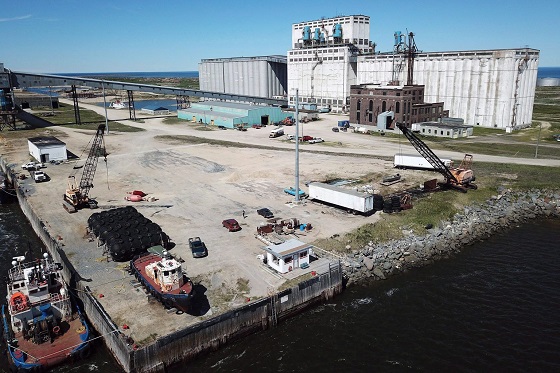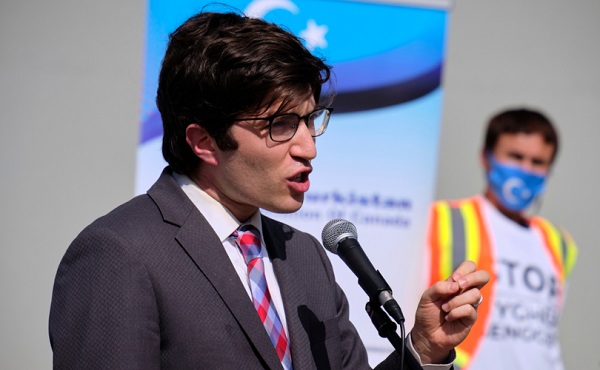Uncategorized
Thai police say they won’t deport Saudi woman seeking asylum

BANGKOK — The head of Thailand’s immigration police said Monday that a young Saudi woman who was stopped in Bangkok as she was trying to travel to Australia for asylum to escape alleged abuse by her family will not be sent anywhere against her wishes.
Rahaf Mohammed Alqunun remained barricaded in an airport hotel room while sending out desperate pleas for help over social media. The 18-year-old began posting on Twitter late Saturday after her passport was taken away when she arrived in the Thai capital on a flight from Kuwait. She has been appealing for aid from the United Nations refugee agency and anyone else who can help.
The refugee agency announced Monday evening that Thai authorities had allowed its officials to meet with Alqunun, but declined to give any details of their meeting, citing confidentiality.
Earlier in the day, Thailand’s immigration police chief, Maj. Gen. Surachate Hakparn, said Alqunun’s father would arrive Monday night, and that officials would see if the young woman was willing to depart with him.
“As of now, she does not wish to go back and we will not force her. She won’t be sent anywhere tonight,” Surachate said at a news conference at the airport where Alqunun is stuck.
“She fled hardship. Thailand is a land of smiles,” he said. “We will not send anyone to die. We will not do that. We will adhere to human rights under the rule of law.”
On Twitter, Alqunun wrote of being in “real danger” if forced to return to her family in Saudi Arabia, and has claimed in media interviews that she could be killed. She told the BBC that she had renounced Islam and is fearful of her father’s retaliation.
Alqunun’s planned forced departure Monday morning was averted as she stayed in her hotel room, with furniture piled up against the door, photos she posted online showed.
Her plight mirrors that of other Saudi women who in recent years have turned to social media to amplify their calls for help while trying to flee abusive families. Alqunun’s Twitter account has attracted tens of thousands of followers in less than 48 hours and her story has grabbed the attention of foreign governments and the U.N. refugee agency.
Her pleas for asylum have also brought international attention to the obstacles women face in Saudi Arabia under male guardianship laws, which require that women, regardless of their age, have the consent of a male relative — usually a father or husband — to travel, obtain a passport or marry.
It also shows the limits of reforms being pushed by Saudi Arabia’s powerful Crown Prince Mohamed bin Salman as he struggles to repair damage to his reputation after the grisly killing three months ago of Saudi writer Jamal Khashoggi by Saudi agents in Istanbul.
Alqunun told Human Rights Watch that she was fleeing beatings and death threats from her male relatives who forced her to remain in her room for six months for cutting her hair.
A Thai court declined to issue an injunction against her being sent back to her parents in Kuwait, from where she began her journey. A family trip to Kuwait apparently allowed her to evade Saudi Arabia’s restrictions on travel.
Phil Robertson, deputy Asia director for Human Rights Watch, told The Associated Press that Thailand should give Alqunun back her passport and let her continue her journey to Australia.
“She has a valid Australian visa,” he said. “The key thing is she should not be sent back to Saudi Arabia, she should not be sent back into harm’s way.”
Immigration police chief Surachate contradicted parts of Alqunun’s story, including her claim that she had an Australian visa. However, he did not show her passport.
Some opposition figures in Australia urged that country’s government to support Alqunun’s efforts.
“I implore the government to do everything they can to help bring this young woman to Australia to give her the opportunity for freedom,” said Australian Sen. Sarah Hanson Young.
For runaway Saudi women, fleeing can be a matter of life and death, and they are almost always doing so to escape male relatives.
In 2017, Dina Ali Lasloom triggered a firestorm online when she was stopped en route to Australia, where she had planned to seek asylum. She was forced to return to Saudi Arabia and was not publicly heard from again, according to activists tracking her whereabouts.
Despite efforts by the Saudi government to curtail the scope of male guardianship laws, women who attempt to flee their families in Saudi Arabia have few good options inside the kingdom. They are often either pressured to reconcile with their families, are sent to shelters where their movement is restricted or face arrest for disobeying their legal guardian.
Alqunun has said she was tricked into giving up her passport upon arrival in Bangkok by a man she has variously identified as a Kuwait Airways employee or a Saudi Embassy official. She said Saudi and Thai officials then told her she would be returned to Kuwait on Monday, where her father and brother are awaiting her.
While the Saudi Embassy in Thailand denies Saudi authorities are involved in attempts to stop Alqunun from
Saudi Arabia’s charge d’affaires in Bangkok, Abdullah al-Shuaibi, was quoted in Saudi media as saying that Alqunun was stopped by Thai authorities because she did not appear to have a return ticket, a hotel reservation or itinerary to show she was a tourist. He said the Saudi Embassy has no authority to stop anyone at the airport and that such a decision would rest with Thai officials.
“She was stopped by airport authorities because she violated Thai laws,” he was quoted as saying in Sabq, a state-aligned Saudi news
___
Batrawy reported from Dubai, United Arab Emirates. Associated Press journalists Tassanee Vejpongsa and Kaweewit Kaewjinda in Bangkok and Sam McNeil in Sydney contributed to this report.
Grant Peck And Aya Batrawy, The Associated Press
Uncategorized
Cost of bureaucracy balloons 80 per cent in 10 years: Public Accounts

The cost of the bureaucracy increased by $6 billion last year, according to newly released numbers in Public Accounts disclosures. The Canadian Taxpayers Federation is calling on Prime Minister Mark Carney to immediately shrink the bureaucracy.
“The Public Accounts show the cost of the federal bureaucracy is out of control,” said Franco Terrazzano, CTF Federal Director. “Tinkering around the edges won’t cut it, Carney needs to take urgent action to shrink the bloated federal bureaucracy.”
The federal bureaucracy cost taxpayers $71.4 billion in 2024-25, according to the Public Accounts. The cost of the federal bureaucracy increased by $6 billion, or more than nine per cent, over the last year.
The federal bureaucracy cost taxpayers $39.6 billion in 2015-16, according to the Public Accounts. That means the cost of the federal bureaucracy increased 80 per cent over the last 10 years. The government added 99,000 extra bureaucrats between 2015-16 and 2024-25.
Half of Canadians say federal services have gotten worse since 2016, despite the massive increase in the federal bureaucracy, according to a Leger poll.
Not only has the size of the bureaucracy increased, the cost of consultants, contractors and outsourcing has increased as well. The government spent $23.1 billion on “professional and special services” last year, according to the Public Accounts. That’s an 11 per cent increase over the previous year. The government’s spending on professional and special services more than doubled since 2015-16.
“Taxpayers should not be paying way more for in-house government bureaucrats and way more for outside help,” Terrazzano said. “Mere promises to find minor savings in the federal bureaucracy won’t fix Canada’s finances.
“Taxpayers need Carney to take urgent action and significantly cut the number of bureaucrats now.”
Table: Cost of bureaucracy and professional and special services, Public Accounts
| Year | Bureaucracy | Professional and special services |
|
$71,369,677,000 |
$23,145,218,000 |
|
|
$65,326,643,000 |
$20,771,477,000 |
|
|
$56,467,851,000 |
$18,591,373,000 |
|
|
$60,676,243,000 |
$17,511,078,000 |
|
|
$52,984,272,000 |
$14,720,455,000 |
|
|
$46,349,166,000 |
$13,334,341,000 |
|
|
$46,131,628,000 |
$12,940,395,000 |
|
|
$45,262,821,000 |
$12,950,619,000 |
|
|
$38,909,594,000 |
$11,910,257,000 |
|
|
$39,616,656,000 |
$11,082,974,000 |
Uncategorized
Trump Admin Establishing Council To Make Buildings Beautiful Again


From the Daily Caller News Foundation
By Jason Hopkins
The Trump administration is creating a first-of-its-kind task force aimed at ushering in a new “Golden Age” of beautiful infrastructure across the U.S.
The Department of Transportation (DOT) will announce the establishment of the Beautifying Transportation Infrastructure Council (BTIC) on Thursday, the Daily Caller News Foundation exclusively learned. The BTIC seeks to advise Transportation Secretary Sean Duffy on design and policy ideas for key infrastructure projects, including highways, bridges and transit hubs.
“What happened to our country’s proud tradition of building great, big, beautiful things?” Duffy said in a statement shared with the DCNF. “It’s time the design for America’s latest infrastructure projects reflects our nation’s strength, pride, and promise.”
“We’re engaging the best and brightest minds in architectural design and engineering to make beautiful structures that move you and bring about a new Golden Age of Transportation,” Duffy continued.
Mini scoop – here is the DOT’s rollout of its Beautifying Transportation Infrastructure Council, which will be tasked with making our buildings beautiful again. pic.twitter.com/
9iV2xSxdJM — Jason Hopkins (@jasonhopkinsdc) October 23, 2025
The DOT is encouraging nominations of the country’s best architects, urban planners, artists and others to serve on the council, according to the department. While ensuring that efficiency and safety remain a top priority, the BTIC will provide guidance on projects that “enhance” public areas and develop aesthetic performance metrics.
The new council aligns with an executive order signed by President Donald Trump in August 2025 regarding infrastructure. The “Making Federal Architecture Beautiful Again” order calls for federal public buildings in the country to “respect regional architectural heritage” and aims to prevent federal construction projects from using modernist and brutalist architecture styles, instead returning to a classical style.
“The Founders, in line with great societies before them, attached great importance to Federal civic architecture,” Trump’s order stated. “They wanted America’s public buildings to inspire the American people and encourage civic virtue.”
“President George Washington and Secretary of State Thomas Jefferson consciously modeled the most important buildings in Washington, D.C., on the classical architecture of ancient Athens and Rome,” the order continued. “Because of their proven ability to meet these requirements, classical and traditional architecture are preferred modes of architectural design.”
The DOT invested millions in major infrastructure projects since Trump’s return to the White House. Duffy announced in August a $43 million transformation initiative of the New York Penn Station in New York City and in September unveiledmajor progress in the rehabilitation and modernization of Washington Union Station in Washington, D.C.
The BTIC will comprise up to 11 members who will serve two-year terms, with the chance to be reappointed, according to the DOT. The task force will meet biannually. The deadline for nominations will end Nov. 21.
-

 Business1 day ago
Business1 day agoNew airline compensation rules could threaten regional travel and push up ticket prices
-

 Great Reset2 days ago
Great Reset2 days agoEXCLUSIVE: The Nova Scotia RCMP Veterans’ Association IS TARGETING VETERANS with Euthanasia
-

 Crime1 day ago
Crime1 day agoHow Global Organized Crime Took Root In Canada
-

 Digital ID2 days ago
Digital ID2 days agoLeslyn Lewis urges fellow MPs to oppose Liberal push for mandatory digital IDs
-

 Digital ID24 hours ago
Digital ID24 hours agoRoblox to Mandate Facial and ID Verification
-

 Business1 day ago
Business1 day agoWill the Port of Churchill ever cease to be a dream?
-

 Health2 days ago
Health2 days agoDisabled Canadians petition Parliament to reverse MAiD for non-terminal conditions
-

 Business1 day ago
Business1 day agoThe numbers Canada uses to set policy don’t add up










